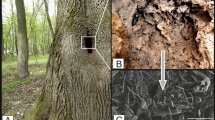Abstract
A PRELIMINARY report by Katznelson and Jamieson1 on the effect of the antibiotic fumagillin (derived from an Aspergillus culture designated H–32) upon the infection of the adult honey bee by the microsporidian Nosema apis indicated promising results. They suggested that the action of the drug was prophylactic in nature, killing the infective amœboid, phase which is released from the spore into the ventricular lumen prior to its entry into the epithelial cells. This view was probably suggested by the results of McCowen et al.3, which showed a depressant action of the drug upon the growth of bacteria-free cultures of Endamœba hystolytica.
Similar content being viewed by others
References
Katznelson, H., and Jamieson, C. A., Science, 115, 70 (1952).
Hanson, F. R., and Eble, E. J., J. Bact., 58, 527 (1949).
McCowen, M. C., Callender, M. E., and Lawlis, J. F., Science, 113, 202 (1951).
Author information
Authors and Affiliations
Rights and permissions
About this article
Cite this article
BAILEY, L. Effect of Fumagillin upon Nosema apis (Zander). Nature 171, 212–213 (1953). https://doi.org/10.1038/171212a0
Issue Date:
DOI: https://doi.org/10.1038/171212a0
- Springer Nature Limited
This article is cited by
-
Myxozoan fish diseases: possible treatment and zoonoses
Journal of Parasitic Diseases (2023)
-
Evaluation of Fumagilin-B® and other potential alternative chemotherapies against Nosema ceranae-infected honeybees (Apis mellifera) in cage trial assays
Apidologie (2016)
-
The effect of dicyclohexylamine and fumagillin on Nosema ceranae-infected honey bee (Apis mellifera) mortality in cage trial assays
Apidologie (2016)
-
Determination of Dicyclohexylamine and Fumagillin in Honey by LC-MS/MS
Food Analytical Methods (2015)





